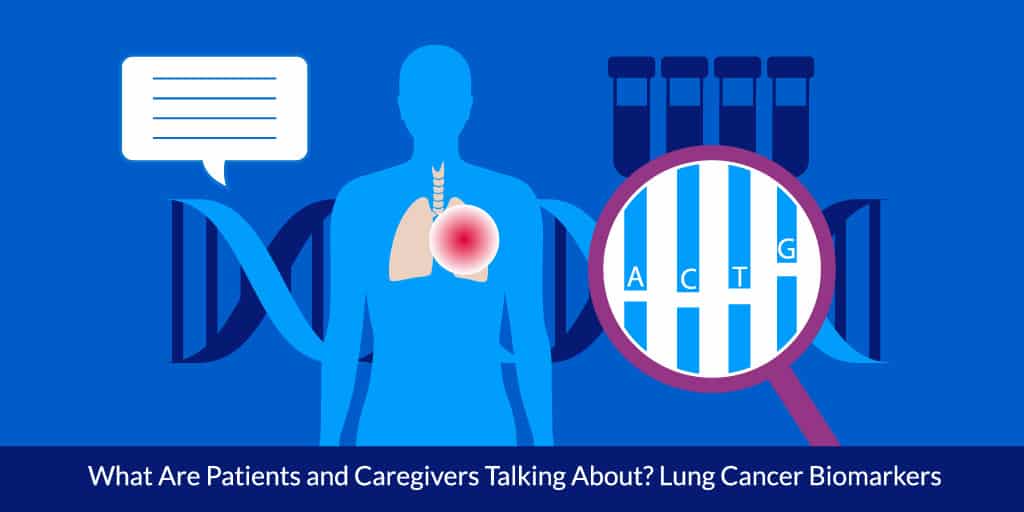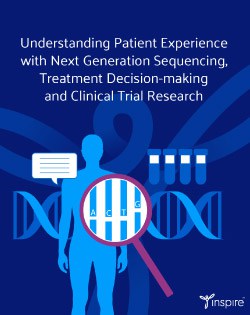What Are Patients and Caregivers Talking About? Lung Cancer Biomarkers

By Kathleen Hoffman, PhD, MSPH
Since the FDA approved the first targeted treatment for NSCLC in 2003, treatment decisions for NSCLC are increasingly made based on individual genomics.1,2 There are now 20 distinct biomarkers that serve as identification points differentiating cancer cells from healthy cells and distinguishing one expression of cancer from another. Science has progressed from identifying tumor cells on a slide to genetic and biochemical identification of NSCLC’s driving agents. Pharma companies are developing and improving increasingly targeted treatments.3 The science is also revealing just how complex lung cancer really is, which is an indicator of why it remains so challenging to treat.4
NSCLC Biomarkers that have treatments associated with them
Next Generation Sequencing (NGS) is used to identify the presence of biomarker mutations. Right now, seven NSCLC driver genes have approved targeted treatments: EGFR, ALK, ROS1, BRAF V600E, NTRK, MET, and RET.5 The level of the PD-L1 protein present in a biomarker test sample is an additional marker that helps identify tumor cells that might benefit from immunotherapy treatment.3
The American Lung Association, Inspire’s community partner for several communities, including Lung Cancer Survivors and Living with Lung Cancer, has recently developed an outstanding patient-centric description of biomarkers calling biomarker testing an essential part of any lung cancer patient’s treatment journey.6 Here is some basic information about the mutated genes and PD-L1 from the ALA:7
Epidermal Growth Factor Receptor (EGFR) mutation
The EGFR mutation is present in about 10-15% of the lung cancers in the US. Patients generally don’t have smoking histories, but this is not always the case. They are typically treated with a TKI inhibitor or an EGFR inhibitor.7
Patients on Inspire discuss their biomarkers and ask about the treatments other patients are receiving.
My doctor told me today my genetic study on the tumor removed showed the presence of Two markers: EGFR 18 and 20. He said I should be able to have targeted treatment with a pill once my chemo ends. Has anyone had these particular markers and gotten the targeted treatment.”
One patient replied, “I have exon 18 and 21 and have been on ____ for almost three years. Best of luck to you on your journey”
Anaplastic Lymphoma Kinase (ALK) gene rearrangement
Gene rearrangement is also called gene fusion. It occurs when two genes inappropriately come together and create novel proteins that stimulate cancerous cell growth.5 About 4% of lung cancers present the ALK gene rearrangement in the tumors, and the patients tend to be younger non-smokers. They are generally treated with a TKI or ALK inhibitor. 7
I’ve been treated for stage 4 non small cell lung cancer (ALK) since February 2015. I’Ve been treated using ______. I’ve been on _____for over 3 years now. It’s been pretty good at keeping the cancer under control. My concern is that I’ve read that one builds a resistance to the drug over time which would require a change in drug. My question is twofold. How long have others been in ____ before coming across this resistance to the drug working and secondly, what would be the next drug after ______ for treatment purposes?
To help, another patient answered,
I was diagnosed in 2017 nscl stage 4 and after getting treatment with Chemo as well as _____ it was found my cancer had mutated to ALK. I have been on ____ for 13 months. Great results so far. All tumors are “gone” And feeling pretty well.
ROS1 rearrangement (or fusion)
About 1-2% of lung cancers are found to be ROS1-positive. While ROS1 can fuse with many partner genes, its most common rearrangement is with gene CD74.7
Caregivers search on Inspire for answers for their loved ones,
My mom has just been diagnosed with Stage IV lung cancer with multiple organ mets including the brain. She was initially told that it was the ROS1 mutation and has been prescribed______ (that she just started yesterday). A few days ago, the doctor called her and said that she also has the EGFR L747_S752del mutation. The doctor said just to go ahead and take the _____and wait and see if it’s working before doing anything else. We are figuring out how to get a 2nd opinion. We are concerned about this additional mutation and what the best course of treatment might be for her. – Does anyone have any thoughts of how we should proceed? – Does anyone else have this and what is your course of treatment?
One answer this caregiver received explained the process of getting a second opinion,
They will treat the mutation with the highest percentage showing on the test. And it sounds like it’s ROS1. Not every mutation has it’s own treatment established as of yet. This may be one of those. I’ve given you a link to the top rated NCI cancer centers. To start a second opinion, you need to choose where. You don’t need to specify a doctor as they all use a tumor board. Then sign a medical release and copies of all records and slides are forwarded. You don’t have to do any of this unless asked to and that would be rare. The tumor board will review your case and then make recommendations.
Another explained the importance of biomarkers,
you need the report on her mutations, they are like your middle name for identifying her cancer…. It is amazing the options now with better genetic testing. Many good positive thoughts to you as you travel this road with your mom. There are many options unheard of 15 years ago and I’m sure more to come.
BRAF V600E mutation
BRAF is both a gene and a protein associated with cell growth. There are many different mutations found in the BRAF gene, but there are two targeted treatments for one of them: BRAF V600E and its associated MEK protein, which are present in about 4% of lung cancers. Patients with other BRAF mutations may be interested in participating in clinical trials.
From the question “Anyone have BRAF mutation?” there were 537 replies including this one.
I am a five year survivor, as of this month, of NSCLC adenocarcinoma ALK positive. I was on _____ for 10 months and then almost 4 years on ____. When I started having progression and ______did not work, another biopsy was done that shows I also now have BRAF mutation. The consensus of the doctors is that BRAF is now driving my cancer. So, I have been prescribed ____and ____. Is there anyone else whose cancer driver has switched from ALK to BRAF? My oncologist has spoken with a number of others who have not heard of or seen this happen with ALK.
NTRK fusion
NTRK fusions are present in different types of cancer, but only in less than 1% of lung cancers. While the chance is rare, it may be important to look for NTRK fusions when undergoing NGS because there are two medications used to treat it in Stage IV patients, entrectinib and larotrectinib.
In a series of posts about less common mutations, one member was looking for new treatments and got this response.
I see your Foundation One test showed multiple mutations. Are they sure EGFR is the primary driver of the cancer? FYI for one of your mutations, NTRK1, there was a recent approval for a very potent drug [drug name] which showed good responses across multiple tumor types, including lung (it received approval for all tumors with NTRK mutations, including lung). I’m not sure this mutation is driving your cancer
Several members recommended a clinical trial that was ongoing to this member.
MET amplification or MET exon 14 skipping
MET exon 14 skipping is a problem in about 5% of cancer patients. A lower percentage of patients have MET amplification. MET is a protein that causes problems when it cannot be broken down and discarded, which happens when part of the MET gene is missing or passed over: exon 14. Two MET inhibitors are approved for treating this problem, but immunotherapy, clinical trials, and chemotherapy are also part of the armamentarium.
One member searched for others with MET Exon 14 skipping…
I’m looking for people with stage 3 or stage 4 adenocarcinoma nsclc with MET Exon 14 skipping or MET exon 14 amplification?
And found someone who shared their experience.
I have met amplification along with EGFR Exon 19 deletion. I’m currently in a clinical trial combining tagrisso with a met inhibitor AZD6094. It’s been successful so far.
RET rearrangements
About 1-2% of lung cancer patients have RET rearrangements or gene fusion that stimulate tumor growth. There are two approved RET-specific TKI inhibitors, selpercatinib and pralsetinib, which are useful until the tumor evolves, after which the more traditional treatments are applied.8
My wife [name] was diagnosed with Stage IV NSCLC [date] After [treatment] a was effective, she went on [treatment] maintenance [for several months]. At that point we discovered the [maintenance] was ineffective and possibly had been months that it was not effective but not visible by MRI or PET. Besides several lung tumors and several bone mets, the cancer also moved to the skull. On[[date] she started a Phase I clinical trial at MD Anderson… Only six other RET fusion lung cancer patients are in the study and all have had significant results. [Name’s] first PET and MRI… showed incredible reduction of the tumors and activity in the skull and Dura. Remarkable results. We recommend anyone with RET Fusion to contact Dr. Vivek Subbiah who heads this study at MD Anderson … Dr. Subbiah encouraged me to send folks to him. Since RET Fusion is so rare, we would also love to connect with others of this mutation to know your experiences. With incredible renewed hope
PD-L1 level
The ALA recommends that all lung cancer patients have their PD-LI levels tested at diagnosis. A high presence of the PD-LI protein is a sign that the tumor may respond to certain immunotherapy drugs.10 The immunotherapy drugs, called checkpoint inhibitors, allow the body’s own T-cells to mark the tumor cells for destruction.11
Caregivers come to Inspire to understand these mutations:
My ___ year old mom was diagnosticated with stage IV adenocarcinoma… She was tested for mutations, EGFR, ALK and PD-L1 and she has a 100% PD-L1 mutation. She had her first treatment this week, …and it went pretty well; the doctor told her that at the beginning, the tumors might grow a little and then they should start shrinking. I have a few questions if anyone can help me, please. I read on the internet that the treatment works very good on people with this mutation in a high score, but I didn’t understand very well on what this PD-L1 is, if it’s good to have these mutations or what is good for. (For more treatment options?) Is it anyone in this condition that experienced a total disparition of the tumors? Or is it even possible to get rid of the whole mass? Thank you in the advance, hope I can get to have my mom for many years form now on.
and they are helped by others.
Hi. The high PD-L1 means she may never have to go through chemo. It makes her a great candidate for immunotherapy… I personally know 2 long term survivors of stage 4 cancer (one is NSCLC and the other is melanoma that has metastasized to the lungs) who have taken [immmunotherapy] and are NEDs (no evidence of disease). Good luck to your mom.
The Importance of Genomic Testing
Members of Inspire’s community recommend genomic testing to those who come looking for answers. But two studies presented at the 2021 ASCO (American Society for Clinical Oncology) annual meeting described some troubling issues around testing. The first surveyed 1,000 US oncologists finding that “…less than 50% of patients were tested for five major biomarkers (ALK, BRAF, EGFR, PD-L1, and ROS-1),” despite the importance of biomarker testing.10 The second found disparities between the number of African American patients obtaining next generation sequencing (NGS) only 39 percent compared to white patients at 50 percent. 11These troubling results show the importance of patient empowerment and education. Read more on these studies here ]“Engaging with Non-Small Cell Lung Cancer and Small Cell Lung Cancer Patients and Caregivers.”
Future Challenges
While progress is being made, the challenges facing lung cancer treatment relate to the complexity of the disease. As NGS continues to reveal the genetic anomalies driving lung cancer, it shows that often an individual’s cancer evolves over time, inducing resistance to treatment. What used to work isn’t working in part because the cancer itself has changed, or because more than one driver is involved in sustaining the cancer while treatments tend to focus on one point of attack. Some drivers are rare. A recent article posited that there may be a route of future treatment that involves recognizing the evolutionary nature of NSCLC and treating it as a chronic condition, rather than a disease to be totally eradicated. In the meantime, 70% of the current clinical trials are focused on targeted NSCLC treatments. NSCLC tumors appear to rapidly evolve as they progress — but so do the approved drugs and immunotherapies, chemotherapy, and surgery.12
Inspire offers a trusted community to patients and caregivers. Our goal with this blog, this website and our content is to provide the life science industry access to the true, authentic patient voice. In so doing, we support faithful operationalization of patient-centricity. Take a look at our case studies, eBooks and news outlet coverage.
References:
1 https://www.cancer.gov/news-events/cancer-currents-blog/2015/fda-gefitinib
2https://www.sciencedirect.com/topics/neuroscience/gefitinib
Goodman, A. “More Widespread Biomarker Testing for NSCLC in Oncology Practices and More Testing in Black Patients: An Urgent Priority.” The ASCO Post. June 8, 2021
3https://www.breakthroughs.com/foundations-science/how-biomarkers-can-help-lung-cancer-treatment
4https://www.nature.com/articles/d42473-020-00479-0#ref-CR10
5 https://www.lungevity.org/sites/default/files/request-materials/LUNGevity-biomarker-testing-booklet-112817.pdf
6https://www.lung.org/lung-health-diseases/lung-disease-lookup/lung-cancer/symptoms-diagnosis/biomarker-testing/biomarker-testing-checklist
7https://www.lung.org/lung-health-diseases/lung-disease-lookup/lung-cancer/symptoms-diagnosis/biomarker-testing
8https://www.sciencedirect.com/science/article/pii/S1556086420300277
9https://www.lung.org/lung-health-diseases/lung-disease-lookup/lung-cancer/symptoms-diagnosis/biomarker-testing/pdl1-pd1-tmb
10Robert, N.J. et al. “Biomarker tissue journey among patients (pts) with untreated metastatic non-small cell lung cancer (mNSCLC) in the U.S. Oncology Network community practices.” ASCO Annual Meeting. Abstract 9004. Presented June 4, 2021.
11Bruno DS et al. “Racial disparities in biomarker testing and clinical trial enrollment in non-small cell lung cancer.” 2021 ASCO Annual Meeting. Abstract 9005. Presented June 4, 2021.
12https://www.nature.com/articles/d42473-020-00479-0






